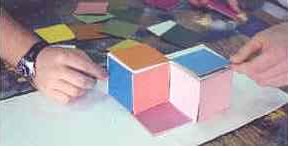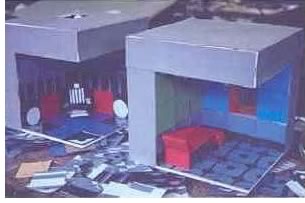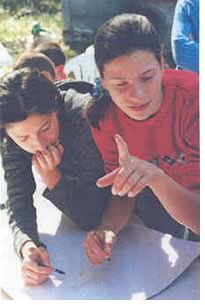

Innovative Academic Programs Receive 2003 Education Honor Awards
A first-year design studio project that encourages communication between architect and client, a program that raises students’ consciousness about observing great architecture, and international workshops that expose students to other cultures received this year’s AIA Education Honor Awards from the AIA Educator/Practitioner Net (EPN).
The program, which recognizes outstanding educators for developing exemplary, innovative, and intellectually challenging courses that address a broad range of issues and contribute to the advancement of architecture education and practice, was juried by John McRae, FAIA, vice president, RTKL; Bob Selby, AIA, professor, University of Illinois Urbana-Champaign; Laura Lee, AIA, professor, Carnegie-Mellon University; and Jeanine Gunderson, Assoc. AIA, vice president, AIAS. The recipients received their awards and presented their courses to their colleagues at the Association of Collegiate Schools of Architecture (ACSA) annual meeting in Louisville last month.
 Honor
Award
Honor
Award
Dialogic Reciprocity: Binding Form-making to Practice in First-year Design, submitted by Christopher Monson, AIA, Mississippi State University
This four-week course “represents significant work in academic/professional
integration because of its grounding in contemporary practice, its unique
theoretical base, and its rare place in an architecture curriculum—first-year
design,” write the people responsible for this innovative class.
The project depends on an architect-practitioner collaborating with a
studio instructor to provide a context of communication practice, ideas
that are broadened conceptually to embrace:
• The relationships of form through composition
• Resistance to ego-induced form-making
• The proper development of the architect/client relationship as
the fundamental basis for design.
 The
studio uses the context of dialogic communication to engage color theory,
figural composition, and spatial-ordering principles in the design of
a small space. With peers acting as critic and client, students apply
methods of ethically bound communication techniques and propose design
solutions that work against their own preconceived willfulness and ego.
Within a context of academic/professional integration, these strategies
argue for a holistic methodology of practice at a moment in design education
that historically has seen it the least—beginning design.
The
studio uses the context of dialogic communication to engage color theory,
figural composition, and spatial-ordering principles in the design of
a small space. With peers acting as critic and client, students apply
methods of ethically bound communication techniques and propose design
solutions that work against their own preconceived willfulness and ego.
Within a context of academic/professional integration, these strategies
argue for a holistic methodology of practice at a moment in design education
that historically has seen it the least—beginning design.
Honorable Mention
Awakening Consciousness Observing Great Practice, submitted by Max Underwood, AIA, Arizona State University
“Great practitioners are conscious to the world—awake to
the core of their being,” Underwood writes. However, he notes, “In
architecture education, little focus is placed on fostering consciousness
in its broadest sense; on developing powers of observation or on intuition.
As students transition into practice, many lack the insight to think deeply
about their profession and ask significant questions.” Underwood’s
course has focused on the practices of Tadao Ando & Associates and
the office of Charles and Ray Eames in an effort to address the questions:
• What is it to be conscious in
the profession of architecture? This query is supported by discussions
on ways of perceiving, knowing, and developing a trajectory of life and
work marked by significant acts of self-renewal and transformation.
• What are the meaningful contributions
I wish to make in the lives of other people, to our collective world?
Here the professor examines great practices and the individuals who make
up that practice.
• What enables a practice to transcend
the norm, make lasting contributions, point the future, and wake the light
in us all? Each student is asked to take their expanded sense of
self and formulate and implement an aspect of “practice” that
reflects their newly forming ideas through three collaborative material
investigations with assistance from local manufacturers, fabricators,
and artisans.
 Building
Communities, submitted by Jan Wampler, FAIA, Massachusetts Institute
of Technology
Building
Communities, submitted by Jan Wampler, FAIA, Massachusetts Institute
of Technology
This international workshop has offered students from MIT the opportunity to travel worldwide to incorporate what they have learned in the classroom into real-life situations, develop design concepts, and see their work through to completion. In all the projects that have been pursued over the past few years, the school was invited to a locale to design a place in close contact with the people of the country. Clients included a university, government agency, or organization needing assistance. In two cases, Honduras and Turkey, the projects were developed as a result of tragedies—an earthquake and a hurricane, respectively. The work, the application notes, was not just solving a problem, but more how to use a problem to design a new approach to the issue. In all cases, there had to be an actual site and clients with a need to build, and not just an academic exercise. Often, initial designs were made during the first visit and discussed with the clients during subsequent conversations and site visits. When a design was agreed upon, it was handed over to local architects and engineers to develop and revise. At the end, a design was ready to build.
Copyright 2003 The American Institute of Architects.
All rights reserved. Home Page ![]()
![]()
 |
||
| Submissions for the 2004 Education Honor Awards will be due in mid-January 2004. For further information, contact Ellen Scanlan Cathey, Assoc. AIA, 202-626-7417.
|
||